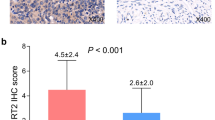Abstract
Objective
The article is to study the expressions of COX-2, VEGF-C, and EGFR in endometrial carcinoma as well as its clinical significances.
Materials and methods
Clinical data of 183 patients with endometrial carcinoma who received surgery as initial treatment in the Nanjing Drum Tower Hospital Affiliated to the Nanjing University Medical School and the Nantong Maternal and Child Health Hospital Affiliated to the Nantong University from January 2005 to December 2010 were retrospectively investigated; 152 out of the 183 patients were closely followed up. Expressions of COX-2, VEGF-C, and EGFR proteins in 152 endometrial carcinoma samples were detected by immunohistochemical S-P assay.
Results
A 5-year survival rate of 152 patients was 81.56% (124/152). Positive COX-2 expression rate was 67.76% (103/152), and its positive expression was related to FIGO stage, differentiation degree, and myometrial invasion depth of patients (P < 0.05), but not to lymph node metastasis (P > 0.05). Positive expression rates of VEGF-C and EGFR were 64.47% (98/152) and 82.24% (125/152), respectively, and their positive expression was associated with FIGO stage, differentiation degree, myometrial invasion depth, and lymphatic metastasis (P < 0.05). Correlation analysis on the expression of COX-2 with VEGF-C and of EGFR found that COX-2 was positively correlated with both VEGF-C and EGFR (P < 0.05, r s > 0). Patient prognosis was associated with the FIGO stage, differentiation degree, and myometrial invasion depth of tumors, as well as the presence or absence of lymph node metastasis (P < 0.05) while showing no significant association with the postoperative adjuvant therapy (P > 0.05).
Conclusion
COX-2, VEGF-C, and EGFR are of significance for determining the FIGO stage, differentiation degree, and myometrial invasion depth of endometrial carcinoma, of which VEGF-C and EGFR are important in determining whether tumors metastasize to lymph nodes. Combined detection of COX-2, EGFR, and VEGF-C can be used as the indices for early diagnosis, recurrence prediction, and outcome evaluation for patients with endometrial carcinoma.



Similar content being viewed by others
References
Sivridis E, Giatromanolaki A, Gatter KC, Harris AL, Koukourakis MI (2002) Association of hypoxia-inducible factors 1α and 2α with activated angiogenic pathways and prognosis in patients with endometrial carcinoma. Cancer 95(5):1055–1063
Lambropoulou M, Alexiadis G, Limberis V, Nikolettors N, Tripsianis G (2005) Clinicopathologic and prognostic of cyclooxygenase-2 expression in endometrial carcinoma. Histol Histopathol 20(3):753–759
Gou HF, Chen XC, Zhu J, Jiang M, Yang Y, Cao D et al (2011) Expressions of COX-2 and VEGF-C in gastric cancer: correlations with lymphangiogenesis and prognostic implications. J Exp Clin Cancer Res 30(1):14–21
He YF, Jin J, Wei W, Chang Y, Hu B, Ji CS et al (2010) Overexpression of cyclooxygenase-2 in noncancerous liver tissue increases the post operative recurrence of hepatocellular carcinoma in patients with hepatitis B virus-related cirrhosis. Can J Gastroenterol 24(7):435–440
Zhang J, Luo J, Ni J, Tang L, Zhang HP, Zhang L et al (2014) MMP-7 is upregulated by COX-2 and promotes proliferation and invasion of lung adenocarcinoma cells. Eur J Histochem 58(1):2262
Fukazawa EM, Baiocchi G, Soares FA, Kumagai LY, Faloppa CC, Badiglian-Filho L et al (2014) COX-2, EGFR, and ERBB-2 expression in cervical intraepithelial neoplasia and cervical cancer using an automated imaging system. Int J Gynecol Pathol 33(3):225–234
Herschman HR (1991) Primary response genes induced by growth factors and tumor promoters. Annu Rev Biochem 60(1):281
Girling JE, Rogers PA (2005) Recent advances in endometrial angiogenesis research. Angiogenesis 8(2):89–99
Leslie KK, Laidler L, Albitar L, Davies S, Holmes A, Nguyen T et al (2005) Tyrosine kinase inhibitors in endometrial cancer. Int J Gynecol Cancer 15(3):409–411
Zhou D, Jing Ye J, Li Y, Lui K, Chen S (2006) The molecular basis of the interaction between the proline-rich SH3-binding motif of PNRC and estrogen receptor alpha. Nucleic Acids Res 34(20):5974–5986
Jasas KV, Fyles A, Elit L, Hoskins P, Biagi J, Dubuclissoir J et al (2004) Phase II study of erlotinib (OSI 774) in women with recurrent or metastatic endometrial cancer; NCIC CTG IND-148. J Clin Oncol 22(14_suppl):5019
Waksal H (1999) Role of an anti-epidermal growth factor in receptor in treating cancer. Cancer Metastasis Rev 18(4):427–436
Livasy CA, Reading FC, Moore DT, Boggess JF, Lininger RA (2006) EGFR expression and HER2/neu overexpression/amplification in endometrial carcinosarcoma. Gynecol Oncol 100(1):101–106
Doraiswamy V, Parrott JA, Skinner MK (2000) Expression and action of transforming growth factor alpha in normal ovarian surface epithelium and ovarian cancer. Biol Reprod 63(3):789–796
Chang AS, Chan HL, To KF (2004) Cyclooxygenase-2 pathway correlates with vascular endothelial growth factor expression and tumor angiogenesis in hepatitis B virus-associated hepatocellular carcinoma. Int J Oncol 24(4):853–860
Toyoki H, Fujimoto J, Sato E (2005) Clinical implications of expression of cyclooxygenase-2 related to angiogenesis in uterine endometrial cancers. Ann Oncol 16(1):51–55
Author information
Authors and Affiliations
Contributions
CS: first author and corresponding author. ZY: resources supporting. HK: resources supporting. DY: resources supporting
Corresponding author
Ethics declarations
Funding
This study was funded by 2010 Nanjing science and technology development project (Grant No: ZK10010).
Conflict of interest
Author Cai Shengnan has received research grants from Nanjing government. Author Cai Shengnan declares that she has no conflict of interest.
Ethical approval
This article does not contain any studies with animals performed by any of the authors. All procedures performed in studies involving human participants were in accordance with the ethical standards of the institutional and/or national research committee and with the 1964 Helsinki declaration and its later amendments or comparable ethical standards.
Informed consent
Informed consent was obtained from all individual participants included in the study.
Rights and permissions
About this article
Cite this article
Cai, S., Zhang, Yx., Han, K. et al. Expressions and clinical significance of COX-2, VEGF-C, and EFGR in endometrial carcinoma. Arch Gynecol Obstet 296, 93–98 (2017). https://doi.org/10.1007/s00404-017-4386-9
Received:
Accepted:
Published:
Issue Date:
DOI: https://doi.org/10.1007/s00404-017-4386-9




